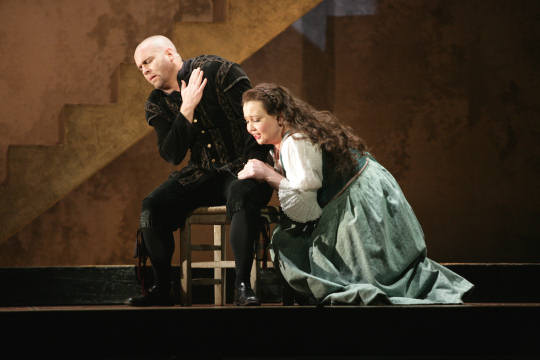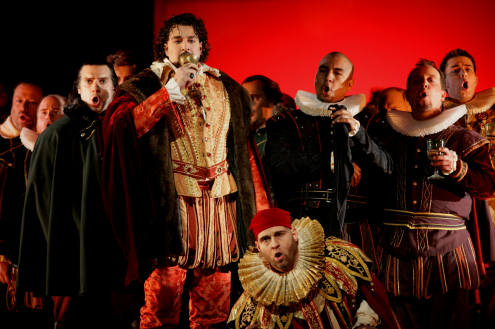Other Links
Editorial Board
-
Editor - Bill Kenny
-
Deputy Editor - Bob Briggs
Founder - Len Mullenger
Google Site Search
SEEN AND HEARD
INTERNATIONAL OPERA REVIEW
Verdi, Rigoletto:
(Revival Premiere) Soloists, Houston Grand Opera Orchestra and
Chorus. Conductor: Patrick Summers. Houston Grand Opera.
17.4.2009 (AS)
Director: Lindy Hume
Sets: Michael Yeargan
Costume designer: Peter J. Hall
Lighting designer: Paul Pyant
Cast:
Duke of Mantua: Eric Cutler
Rigoletto: Scott Hendricks
Gilda: Albina Shagimuratova
Sparafucile: Andrea Silvestrelli
Maddalena: Maria Markina
Marullo:
Octavio Moreno
Monterone: Bradley Garvin
Ceprano: Adam Cioffari
Borsa: Shon Sims
Countess Ceprano/a page: Faith Sherman
Giovanna: Jamie Barton
Usher: Tommy Ajai George
Shagimuratova shines in Houston’s Rigoletto

Scott Hendricks ( Rigoletto) and Albina Shagimuratova (Gilda)
Houston Grand
Opera’s opening night performance of Verdi’s Rigoletto was nearly as
powerful as the thunderstorms that raged outside the Brown Theater. The sold-out Houston crowd that braved the weather saw their devotion
rewarded with one of the most moving performances of Gilda the city has ever
seen, in the form of Uzbek soprano and former HGO Studio alumna Albina
Shagimuratova.
From the first duet Shagimuratova shared with Scott Hendricks (Rigoletto), the
audience knew something special was happening. No stranger to HGO, the soprano
still brings something new and fresh to each role she has performed with the
company. Her Gilda was no different. Shagimuratova’s voice rang clearly
throughout the entire house, displaying perfect coloratura without ever becoming
shrill or forced. Her rendition of “Caro nome” left the audience speechless,
only to be followed by a well deserved roar of approval at the passionate,
youthful singing put forth by the burgeoning soprano. If this Gilda is any
indication of the rest of her career, she has much to look forward to in the
years ahead of her.
Perhaps the person most thankful for Shagimuratova’s outstanding performance
was baritone Scott Hendricks as Rigoletto, who managed to stay out of the
spotlight with a portrayal that left something to be desired. Hendricks, a Texas
native, struggled with a muffled, swallowed sound for most of the night and left
little impression of a distraught and ashamed father. His version of the
jester’s diatribe, “Cortigiani, vil razza dannata,” lacked the vocal ring and
power needed for the first half of the aria, only slightly improving during the
second, lyrical section. His acting needs a little work too; Hendricks has a
strange propensity to wave his arms around at the end of fermatas, and he seemed
unusually emotionless during “Tutte le feste al tempio.” Perhaps he was
having an off-night for some reason.

Eric Cutler
as The Duke
Eric Cutler
fared better in his role debut as the Duke of Mantua. The Iowa native is known
mostly for his bel canto roles, and this venture into Verdi didn’t show him far
from his home ground. Instead of adding too much heft to his sound, the
tenor stayed loyal to his voice and sang everything with the naturally light
mechanism for which he is best known. This strategy worked well in his Act II aria
and cabaletta, and he maintained surprising strength throughout “Bella figlia
dell’amore” in Act III. Cutler also acted well, maintaining a nice balance
between arrogance, pride, lust and humor (of which there is plenty in Piave’s
libretto).
The villainous brother-sister duo of Andrea Silvestrelli (Sparafucile) and Maria
Markina (Maddalena) also proved particularly well sung and acted.
Silvestrelli’s booming basso profundo commanded every one of his scenes with
perfect diction, a strong top, and plenty of power (especially in the Storm
Trio). The Italian’s imposing presence created a comical dichotomy to Markina’s
diminutive stature. The Russian mezzo, who is a current member of HGO’s young
artist studio, sang with a dark, warm voice and held her own in the quartet (in
which she did quite a bit more than just fool around with Eric Cutler’s
Duke). Her seductive voice and stage presence should prove well for her budding
career.
All supporting roles were sung decently, with special credit going to baritone
Bradley Garvin as Monterone. During Garvin’s brief scene in Act I, he sang
powerfully and without any bluster, showing that he has the heft for heavier
roles in the future. Stage director Lindy Hume played it mostly safe, with a
few interesting choices (such as having Maddalena murder Gilda instead of
Sparafucile) and a few not-so interesting choices (like turning on the in-house
lights for Cutler’s “La donna e’ mobile”). Houston Grand
Opera music director Patrick Summers led a lively reading of the overture but
didn’t fuss with tempi too much over the course of the evening, providing
excellent support for his singers.
The production, last seen at HGO in 2001, is a joint effort with Dallas Opera
and a revival of Michael Yeargan’s classic setting, inspired by Italian
painter Giorgio di Chirico. It relies heavily on muraled backdrops of pastoral
and river settings to create the mood. A two-tiered false proscenium set the
stage for the first act, with deep red lighting tones creating the lustful mood
of the Duke's orgy. A simple cut out house frame slid out onto the stage after
"Pari siamo," giving the audience a believable home for Gilda and Rigoletto.
Act III reused this set with darkened lighting for Sparafucile's lair. Other
than these, props and other sets were used sparingly -a few chairs here and
there and a bed for the Duke in Act II. The production extended the "storm"
mood backwards from the last act to the first: the design team used fog in
several instances, giving characters the opportunity to hide not behind sets
but in and out of smoke and darkness. The lighting was simple and mostly
elegant save when Hume (or lighting designer Pyant) had the rather clichéd idea
of turning up the house lights during Cutler's "La donna e' mobile."
In the end, it was Albina Shagimuratova’s night to shine. If the
Uzbekistan-born soprano hadn’t already burst onto the scene, this opening night
confirmed her status as one of the most talented Gildas on stage today. It’s
not often that a soprano’s performance as Gilda can overshadow the title character
in Rigoletto, but Shagimuratova did just that, and the Houston audience was very grateful
to her.
Aaron Smith
Pictures © Felix Sanchez
Back
to Top
Cumulative Index Page
